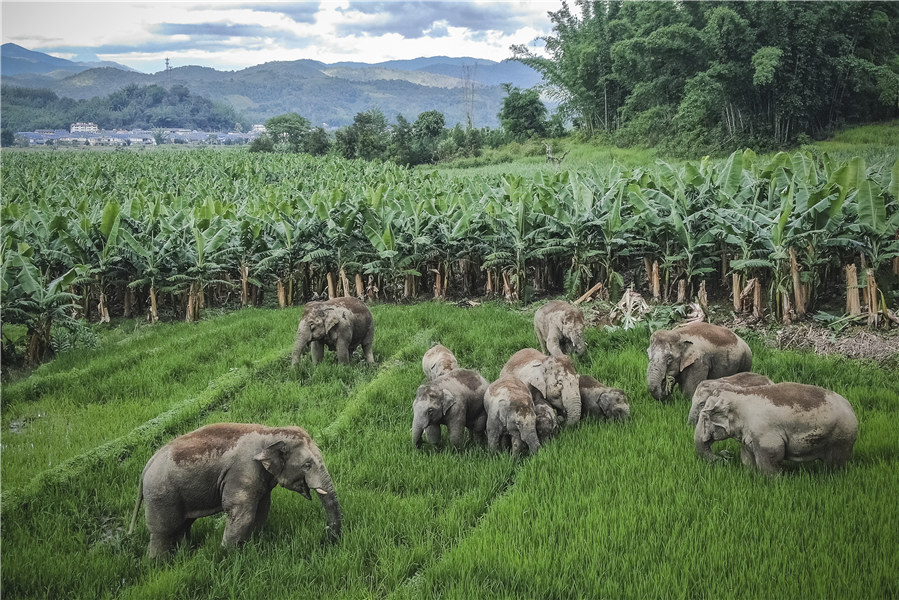
From the People's Daily app.
And this is Story in the Story.
Thanks to improving the environment, the number of wild Asian elephants, which are under A-level state protection, has grown from 170 in the 1990s to about 300.
In 2019, for the first time ever, researchers at the Asian Elephant Breeding and Rescue Center in Xishuangbanna Dai Autonomous Prefecture used artificial breeding techniques to breed an Asian baby elephant.
Monitoring in the early days used to rely solely on the experience of the forest rangers.
Later, monitoring teams implemented drones and infrared cameras to locate the elephants.
However, the increase in numbers has led to more human-elephant conflict.
The elephants also enjoy eating sugar cane, with local farmers wondering how they can be compensated for their losses.
Technology aside, a long-term solution has yet to be established.
Today’s Story in the Story looks at the Asian elephant and how China’s preservation efforts have impacted its population and the region where they live.

In the past four years, in Meng'a, Yunnan province, the Asian elephants have fed on crops such as sugar cane, corn, bamboo and bananas grown by local farmers. (Photo: China Daily)
Wildlife authorities in southwest China's Yunnan Province released an Asian elephant they captured back into the wild.
The 20-year-old elephant Weizhayo, meaning “winner” in the Dai language, was an underdog in a fight for a mate and turned fractious after being expelled from the pack by the winning alpha, according to the forestry and grassland administration of Dai Autonomous Prefecture of Xishuangbanna.
The 4-ton animal intruded into Meng'a Town, Menghai County, six times between March 17 and April 4, tramping crowded roads and damaging 16 motor vehicles and five buildings.
After meeting with experts, the provincial forestry authority approved the request for an "arrest." The prefecture government then formulated a hunting plan and an emergency pre-plan and set up an operation command.
In a separate incident, an elephant invaded Meng'a and walked around a school and a sugarhouse. The hunt was on.
An anesthetist stalked on the target near the town government building and shot a 1.2-ml narcotic needle in its rear using a blowpipe.
After 12 minutes, Weizhayo fell slowly to the ground and was caged. He woke up 35 minutes later showing typical vital signs and was sent to the center, "safe and sound."
During mating season, competition between male elephants can be intense and lead to frequent fights, imperiling residents in the area.
A wild Asian elephant came into the city of Pu'er last April and took a stroll for six hours before it was brought under control and kept in the elephant breeding and rescue center in Xishuangbanna.
In June, an elephant habitat reconstruction project was launched in Yunnan to build a 51-hectare "dining area" for wild elephants to solve conflicts between the endangered animal and local residents.

An elephant is captured with experts' consent. This elephant wrecked 40 vehicles within a week. (Photo: China Daily)
This group of Asian elephants is exceptionally aggressive. Although there are only 18 of them, the herd has accounted for 57 percent of the total casualties caused by Asian elephants in the whole of China.
Every day monitors update more than a dozen messages on the elephant warning platform and notify the forestry bureau and villagers through a mobile phone app in a bid to reduce the encounters between the villagers and the elephants.
Although these methods can accurately establish the position of the elephants, it is not a long-term strategy. The dilemma facing the monitors is how to reduce troublesome human and elephant encounters and prevent disasters, while at the same time preserving the area's biodiversity.
Years of experience have led to a consensus within the Menghai county forestry bureau and elephant protection organizations that are building a food source for the elephants is a must.
In addition to the damage to crops and housing estates, what worried the monitors the most is the safety of the villagers. "The elephants are often found near the hot spring dam and the banana land."
The project, in conjunction with the local forestry bureau, has recruited 30 villagers to transform hundreds of acres of land into elephant food sources.
Cameras set up in these areas have already captured pictures of the elephants eating in the designated areas.
It is a luxury for the locals to live in harmony with the elephants, and the villagers in Meng'a are unwilling - and unable - to domesticate them.
As the elephants won't disappear into the deep forest, thanks to the efforts of the project workers and the forestry bureau, the dream of living harmoniously alongside the pesky pachyderms is becoming a reality.
(Produced by Nancy Yan Xu, Lance Crayon, Brian Lowe and Paris Yelu Xu. Music by: bensound.com. Text from China Daily and Global Times.)


